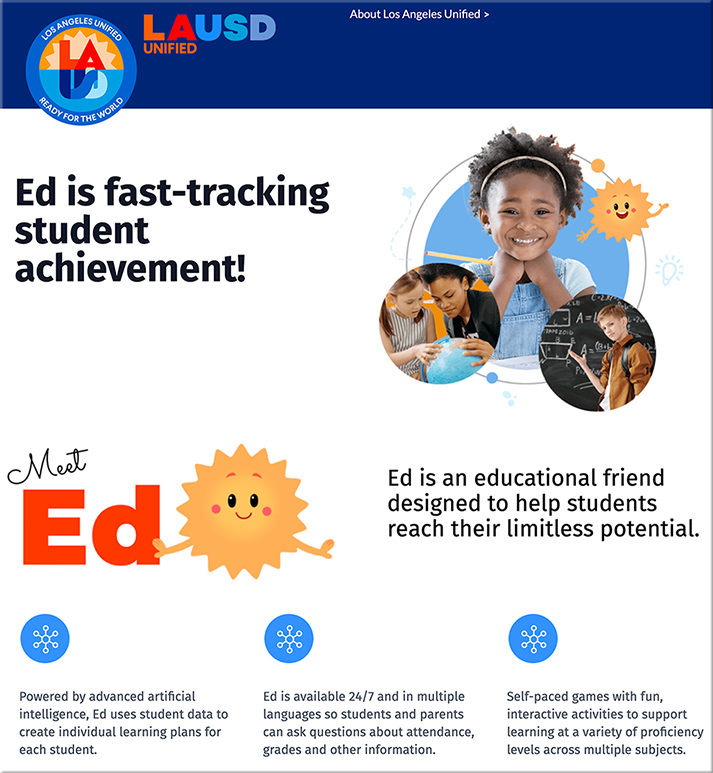How Generative AI Owns Higher Education. Now What? — from forbes.co by Steve Andriole
Excerpt (emphasis DSC):
What about course videos? Professors can create them (by lecturing into a camera for several hours hopefully in different clothes) from the readings, from their interpretations of the readings, from their own case experiences – from anything they like. But now professors can direct the creation of the videos by talking – actually describing – to a CustomGPTabout what they’d like the video to communicate with their or another image. Wait. What? They can make a video by talking to a CustomGPT and even select the image they want the “actor” to use? Yes. They can also add a British accent and insert some (GenAI-developed) jokes into the videos if they like. All this and much more is now possible. This means that a professor can specify how long the video should be, what sources should be consulted and describe the demeanor the professor wants the video to project.
From DSC:
Though I wasn’t crazy about the clickbait type of title here, I still thought that the article was solid and thought-provoking. It contained several good ideas for using AI.
Excerpt from a recent EdSurge Higher Ed newsletter:
There are darker metaphors though — ones that focus on the hazards for humanity of the tech. Some professors worry that AI bots are simply replacing hired essay-writers for many students, doing work for a student that they can then pass off as their own (and doing it for free).
From DSC:
Hmmm…the use of essay writers was around long before AI became mainstream within higher education. So we already had a serious problem where students didn’t see the why in what they were being asked to do. Some students still aren’t sold on the why of the work in the first place. The situation seems to involve ethics, yes, but it also seems to say that we haven’t sold students on the benefits of putting in the work. Students seem to be saying I don’t care about this stuff…I just need the degree so I can exit stage left.
My main point: The issue didn’t start with AI…it started long before that.
And somewhat relevant here, also see:
I Have Bigger Fish to Fry: Why K12 Education is Not Thinking About AI — from medium.com by Maurie Beasley, M.Ed. (Edited by Jim Beasley)
This financial stagnation is occurring as we face a multitude of escalating challenges. These challenges include but are in no way limited to, chronic absenteeism, widespread student mental health issues, critical staff shortages, rampant classroom behavior issues, a palpable sense of apathy for education in students, and even, I dare say, hatred towards education among parents and policymakers.
…
Our current focus is on keeping our heads above water, ensuring our students’ safety and mental well-being, and simply keeping our schools staffed and our doors open.
Meet Ed: Ed is an educational friend designed to help students reach their limitless potential. — from lausd.org (Los Angeles School District, the second largest in the U.S.)
What is Ed?
An easy-to-understand learning platform designed by Los Angeles Unified to increase student achievement. It offers personalized guidance and resources to students and families 24/7 in over 100 languages.
Also relevant/see:
- Los Angeles Unified Bets Big on ‘Ed,’ an AI Tool for Students — from by Lauraine Langreo
The Los Angeles Unified School District has launched an AI-powered learning tool that will serve as a “personal assistant” to students and their parents.The tool, named “Ed,” can provide students from the nation’s second-largest district information about their grades, attendance, upcoming tests, and suggested resources to help them improve their academic skills on their own time, Superintendent Alberto Carvalho announced March 20. Students can also use the app to find social-emotional-learning resources, see what’s for lunch, and determine when their bus will arrive.
Could OpenAI’s Sora be a big deal for elementary school kids? — from futureofbeinghuman.com by Andrew Maynard
Despite all the challenges it comes with, AI-generated video could unleash the creativity of young children and provide insights into their inner worlds – if it’s developed and used responsibly
Like many others, I’m concerned about the challenges that come with hyper-realistic AI-generated video. From deep fakes and disinformation to blurring the lines between fact and fiction, generative AI video is calling into question what we can trust, and what we cannot.
And yet despite all the issues the technology is raising, it also holds quite incredible potential, including as a learning and development tool — as long as we develop and use it responsibly.
I was reminded of this a few days back while watching the latest videos from OpenAI created by their AI video engine Sora — including the one below generated from the prompt “an elephant made of leaves running in the jungle”
…
What struck me while watching this — perhaps more than any of the other videos OpenAI has been posting on its TikTok channel — is the potential Sora has for translating the incredibly creative but often hard to articulate ideas someone may have in their head, into something others can experience.
Can AI Aid the Early Education Workforce? — from edsurge.com by Emily Tate Sullivan
During a panel at SXSW EDU 2024, early education leaders discussed the potential of AI to support and empower the adults who help our nation’s youngest children.
While the vast majority of the conversations about AI in education have centered on K-12 and higher education, few have considered the potential of this innovation in early care and education settings.
At the conference, a panel of early education leaders gathered to do just that, in a session exploring the potential of AI to support and empower the adults who help our nation’s youngest children, titled, “ChatECE: How AI Could Aid the Early Educator Workforce.”
Hau shared that K-12 educators are using the technology to improve efficiency in a number of ways, including to draft individualized education programs (IEPs), create templates for communicating with parents and administrators, and in some cases, to support building lesson plans.
Again, we’ve never seen change happen as fast as it’s happening.
Enhancing World Language Instruction With AI Image Generators — from eduoptia.org by Rachel Paparone
By crafting an AI prompt in the target language to create an image, students can get immediate feedback on their communication skills.
Educators are, perhaps rightfully so, cautious about incorporating AI in their classrooms. With thoughtful implementation, however, AI image generators, with their ability to use any language, can provide powerful ways for students to engage with the target language and increase their proficiency.
AI in the Classroom: A Teacher’s Toolkit for Transformation — from esheninger.blogspot.com by Eric Sheninger
While AI offers numerous benefits, it’s crucial to remember that it is a tool to empower educators, not replace them. The human connection between teacher and student remains central to fostering creativity, critical thinking, and social-emotional development. The role of teachers will shift towards becoming facilitators, curators, and mentors who guide students through personalized learning journeys. By harnessing the power of AI, educators can create dynamic and effective classrooms that cater to each student’s individual needs. This paves the way for a more engaging and enriching learning experience that empowers students to thrive.
Teachers Are Using AI to Create New Worlds, Help Students with Homework, and Teach English — from themarkup.org by Ross Teixeira; via Matthew Tower
Around the world, these seven teachers are making AI work for them and their students
In this article, seven teachers across the world share their insights on AI tools for educators. You will hear a host of varied opinions and perspectives on everything from whether AI could hasten the decline of learning foreign languages to whether AI-generated lesson plans are an infringement on teachers’ rights. A common theme emerged from those we spoke with: just as the internet changed education, AI tools are here to stay, and it is prudent for teachers to adapt.
Teachers Desperately Need AI Training. How Many Are Getting It? — from edweek.org by Lauraine Langreo
Even though it’s been more than a year since ChatGPT made a big splash in the K-12 world, many teachers say they are still not receiving any training on using artificial intelligence tools in the classroom.
More than 7 in 10 teachers said they haven’t received any professional development on using AI in the classroom, according to a nationally representative EdWeek Research Center survey of 953 educators, including 553 teachers, conducted between Jan. 31 and March 4.
From DSC:
This article mentioned the following resource:
Artificial Intelligence Explorations for Educators — from iste.org











